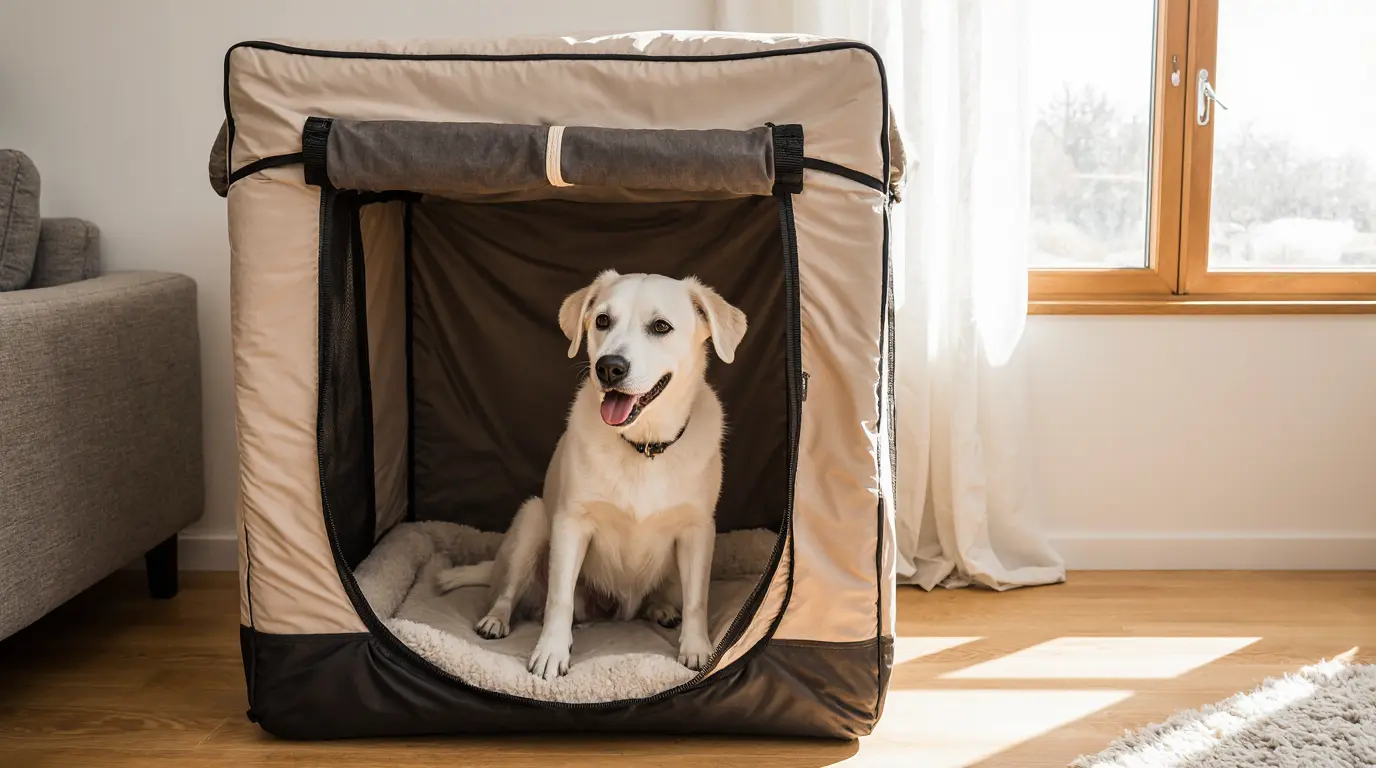Crate Training Your Dog: 9 Easy Steps for Success
Look, I get it. When I first saw my neighbor setting up a crate for their new puppy, I thought they were being pretty harsh. The whole thing looked like doggy jail to me. But after dealing with my own rescue dog’s separation anxiety and watching him destroy half my living room furniture, I realized I might’ve been completely wrong about this whole crate thing.
Turns out, dogs actually love having their own space. Who knew? My golden retriever, Max, now practically sprints to his crate when he’s tired. It’s become his favorite hangout spot, and honestly, I’m a little jealous of how cozy he looks in there.
The thing about crate training is that it’s not really about teaching your dog to tolerate being locked up. It’s more like giving them their own bedroom in your house. You know how you feel when you finally get to your own bed after a long day? That’s what we’re going for here.
Anna Flayton, who trains dogs at PUPS Pet Club in Chicago, told me something that really stuck with me. She said dogs who learn to love their crates early on actually handle stress way better than dogs who don’t have that safe space to retreat to. Makes sense when you think about it.
Step 1: Pick the Right Crate (This Actually Matters More Than You Think)
I made the rookie mistake of buying the cheapest crate I could find online. Big mistake. Three weeks later, Max had somehow bent the door and was using it as a chew toy. Don’t be me.
You want something sturdy that’ll last more than a few months. There are basically two types that work well: the airline-style ones that look like little caves, and the wire ones that let your dog see everything that’s happening.
Max loves his wire crate because he’s nosy and wants to watch everything. But my friend’s lab prefers the enclosed style because she gets overstimulated easily. Your dog will let you know what they like.
Here’s the tricky part about sizing – don’t get a massive crate thinking you’re being nice. I almost bought one big enough for a Great Dane because I wanted Max to be “comfortable.” Thank goodness the store clerk stopped me. Dogs won’t use a huge crate as a bathroom if it’s the right size, but give them too much room and all bets are off.
Get one that fits their adult size and use a divider to make it smaller while they’re growing. Trust me on this one.
Step 2: Start When They’re Chill (Not When They’re Bouncing Off the Walls)
I learned this the hard way. My first attempt at introducing Max to his crate happened right after I got home from work when he was doing his usual “you’re home, you’re home, you’re home!” dance. Bad timing.
Dogs need to associate the crate with calm, relaxing vibes. So wait until after dinner when they’re getting sleepy, or after a good walk when they’re naturally winding down.
Start small – like really small. Ten minutes max at first. I know it doesn’t seem like much, but you’re building a foundation here. Max went from ten minutes to sleeping through the night in his crate, but it took months, not days.
Step 3: Skip the Fancy Bedding (At Least Initially)
I spent way too much money on a fancy orthopedic dog bed for Max’s crate. He peed on it the second day and then tore it into a million pieces when I wasn’t looking. Live and learn.
Most dogs are perfectly happy sleeping on the hard crate mat. It stays cool, they can’t destroy it, and they can’t use it as a bathroom. You can always add bedding later once they’ve proven they’re not going to treat their crate like a playground.
Some dogs actually prefer the hard surface anyway. Max still chooses to sleep on the kitchen tiles half the time, even though he has three different beds around the house.
Step 4: Make Going In the Crate the Best Thing Ever
This is where the magic happens. Every time Max goes into his crate, something awesome needs to happen. I use frozen KONGs stuffed with peanut butter, and let me tell you, it works like a charm.
The beauty of frozen KONGs is that they keep dogs busy for ages. Max can spend forty-five minutes working on one, and by the time he’s done, he’s tired and ready for a nap anyway. It’s like built-in crate training.
You don’t have to use KONGs though. Whatever your dog goes absolutely crazy for – that’s what goes in the crate. Some dogs love puzzle toys, others prefer bully sticks. Figure out what makes your dog’s tail wag and save it for crate time.
Step 5: Don’t Overdo It (Your Dog Still Needs a Life)
I made another mistake early on by thinking the crate was a magic solution to all my problems. Left Max in there for six hours on a Saturday because I had errands to run. Came home to a very unhappy dog and a mess to clean up.
Dogs need time to be dogs. They need to play, eat, drink water, and go to the bathroom. Puppies especially can’t hold it very long – roughly one hour for every month of age, plus one extra hour if you’re lucky.
Keep track of how long your dog’s been crated and make sure you’re giving them plenty of free time. The crate should enhance their life, not replace it.
Step 6: Turn It Into a Game
Once Max got comfortable with his crate, I started incorporating it into our playtime. Sometimes I’d throw his tennis ball in there during fetch. Other times I’d hide treats inside for him to find.
The goal is making the crate part of the fun stuff, not just the place he goes when I leave. Now Max will randomly go hang out in his crate during the day, even when the door’s wide open. That’s when you know you’ve succeeded.
Get creative with this. Every dog is different, but most of them love games that involve finding things or chasing things into their crate.
Step 7: Safety First – No Accessories in the Crate
This one’s non-negotiable. Max doesn’t wear his collar, tags, or anything else when he’s crated. I learned this from a scary story my vet told me about a dog who got their collar caught on the crate bars.
It might seem harmless, but even something as simple as a collar can turn dangerous in a confined space. Better safe than sorry.
Step 8: Take Baby Steps When Increasing Time
When Max got comfortable being crated for thirty minutes, I didn’t jump straight to three hours. I went to forty-five minutes, then an hour, then ninety minutes. Small increases feel manageable to your dog and set you both up for success.
I also got one of those dog cameras so I could check on him when I was out. Watching him on my phone helped me figure out when he was truly relaxed versus when he was still anxious. Some days he’d be sleeping peacefully after twenty minutes. Other days he’d pace for an hour before settling down.
The camera was worth every penny for my peace of mind, and it helped me make better decisions about when to push a little further and when to back off.
Step 9: Patience is Everything (And I Mean Everything)
Here’s the reality check nobody talks about: crate training takes forever. Well, not forever, but at least six months of consistent work. Some dogs pick it up faster, others take longer. Max was somewhere in the middle.
There were days when I thought we’d finally figured it out, and then he’d have a complete meltdown about going in his crate. There were weeks when everything seemed perfect, followed by setbacks that made me question everything.
Dogs don’t learn in straight lines. They have good days and bad days, just like we do. The key is staying consistent with your approach and not giving up when things get frustrating.
I can’t tell you how many times I wanted to just give up and let Max have free run of the house. But sticking with it was worth it. Now he’s got his own space where he feels secure, and I don’t worry about coming home to chewed-up furniture or accidents on the carpet.
The whole process taught me that training isn’t about forcing your dog to do what you want. It’s about helping them discover that what you want is actually pretty great for them too. Max’s crate went from being this scary cage thing to being his favorite spot in the house.
That transformation didn’t happen overnight, but when it finally clicked, it was worth every frustrating moment we went through to get there.


